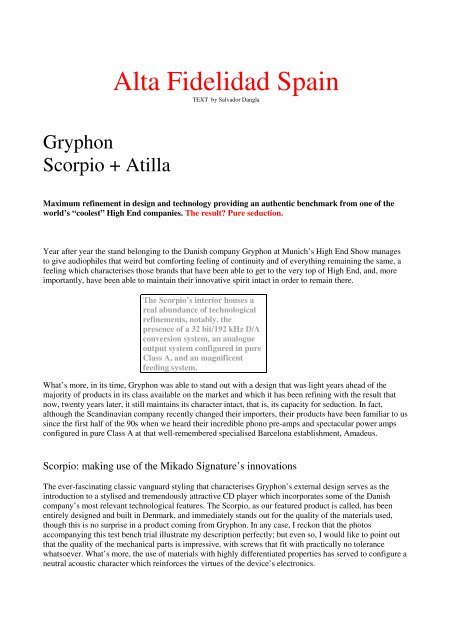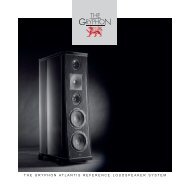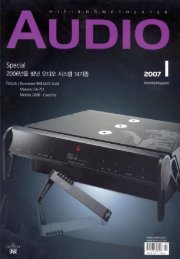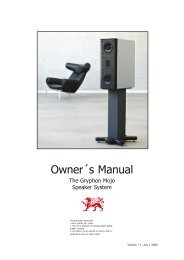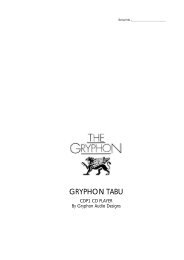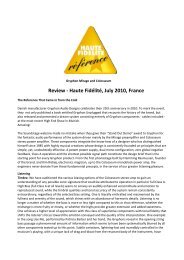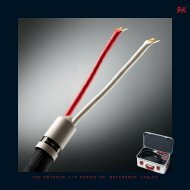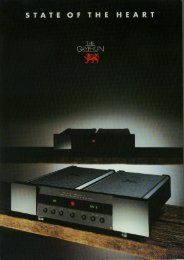Review by Alta Fidelidad Products: Scorpio & Atilla Country: Spain
Review by Alta Fidelidad Products: Scorpio & Atilla Country: Spain
Review by Alta Fidelidad Products: Scorpio & Atilla Country: Spain
You also want an ePaper? Increase the reach of your titles
YUMPU automatically turns print PDFs into web optimized ePapers that Google loves.
Gryphon<br />
<strong>Scorpio</strong> + <strong>Atilla</strong><br />
<strong>Alta</strong> <strong>Fidelidad</strong> <strong>Spain</strong><br />
TEXT <strong>by</strong> Salvador Dangla<br />
Maximum refinement in design and technology providing an authentic benchmark from one of the<br />
world’s “coolest” High End companies. The result? Pure seduction.<br />
Year after year the stand belonging to the Danish company Gryphon at Munich’s High End Show manages<br />
to give audiophiles that weird but comforting feeling of continuity and of everything remaining the same, a<br />
feeling which characterises those brands that have been able to get to the very top of High End, and, more<br />
importantly, have been able to maintain their innovative spirit intact in order to remain there.<br />
The <strong>Scorpio</strong>’s interior houses a<br />
real abundance of technological<br />
refinements, notably, the<br />
presence of a 32 bit/192 kHz D/A<br />
conversion system, an analogue<br />
output system configured in pure<br />
Class A, and an magnificent<br />
feeding system.<br />
What’s more, in its time, Gryphon was able to stand out with a design that was light years ahead of the<br />
majority of products in its class available on the market and which it has been refining with the result that<br />
now, twenty years later, it still maintains its character intact, that is, its capacity for seduction. In fact,<br />
although the Scandinavian company recently changed their importers, their products have been familiar to us<br />
since the first half of the 90s when we heard their incredible phono pre-amps and spectacular power amps<br />
configured in pure Class A at that well-remembered specialised Barcelona establishment, Amadeus.<br />
<strong>Scorpio</strong>: making use of the Mikado Signature’s innovations<br />
The ever-fascinating classic vanguard styling that characterises Gryphon’s external design serves as the<br />
introduction to a stylised and tremendously attractive CD player which incorporates some of the Danish<br />
company’s most relevant technological features. The <strong>Scorpio</strong>, as our featured product is called, has been<br />
entirely designed and built in Denmark, and immediately stands out for the quality of the materials used,<br />
though this is no surprise in a product coming from Gryphon. In any case, I reckon that the photos<br />
accompanying this test bench trial illustrate my description perfectly; but even so, I would like to point out<br />
that the quality of the mechanical parts is impressive, with screws that fit with practically no tolerance<br />
whatsoever. What’s more, the use of materials with highly differentiated properties has served to configure a<br />
neutral acoustic character which reinforces the virtues of the device’s electronics.
More than anything, the truth is that the <strong>Scorpio</strong> is pure-state technology, though it is a technology that is<br />
not in the least improvised but the fruit of successive, well-studied improvements carried out on models<br />
which preceded it, or which rank higher in Gryphon’s range. Such is the case of an innovation that we have<br />
already seen in some elite Japanese products: the use of asynchronous 32 bit/192 kHz converters from AKM.<br />
The <strong>Scorpio</strong> takes no fewer than four of these sophisticated devices and arranges them in a configuration that<br />
can exploit the possibilities of the now "old" - who would have imagined it! – CD to an astonishing degree,<br />
after oversampling of the latter’s 16 bits/44.1 kHz to 32 bits/192 kHz.<br />
So that everything fits in from a musical point of view, clearly much, much more is needed. And the<br />
Gryphon does not fall short in that respect, believe you me, as in its interior we find refinements such as two<br />
temperature compensated quartz oscillators, custom-made for Gryphon, whose accuracy is better than 5 parts<br />
per million (ppm). What’s more, it is equipped with a smooth-slope digital filter to optimise high frequency<br />
response, a first-order analogue output filter, analogue circuitry configured in pure Class A and built with<br />
discrete components, and a feeding system with regulated voltage sources of +/- 20 V which includes<br />
separate torodial transformers for the analogue and digital sections and nothing less than a reserve of<br />
power/capacity filter of 15,000 uF per channel. And all that, of course, with minimised signal paths.<br />
<strong>Atilla</strong>: Gryphon’s latest revelation<br />
This is the latest Gryphon to arrive in our country, a product designed for those who want top benchmark<br />
performance from electronic signal processing and amplification, but prefer the convenience and<br />
compactness of an integrated amplifier. We announced its arrival recently, and the truth is that the unit<br />
being tested here is one of the best – if not the best – to arrive in our country. As with the <strong>Scorpio</strong>, and<br />
<strong>by</strong> extension, the rest of Gryphon’s products, the <strong>Atilla</strong> is a machine with an extremely “cool” design that<br />
has been built in the best materials to the most stringent and exacting standards. Among its outstanding<br />
features are the detachable feet and the integrated speaker terminals (real luxury, but also practical as they<br />
allow the use of any cable you fancy), though, as with the <strong>Scorpio</strong>, “it’s what’s inside that really matters”.<br />
And the truth is that simply reviewing the raft of technological innovations incorporated into the <strong>Atilla</strong> is<br />
almost overwhelming. Apart from the usual dual mono circuit topography, we must point out the complete<br />
absence of negative feedback, the maximum reduction in signal paths (with very little wiring, a feature<br />
which is becoming more and more highly valued <strong>by</strong> the most perfectionist of audiophiles), and the use of<br />
very sophisticated components. Among the components, the following features stand out in particular: the<br />
military-origin double-faced printed circuit boards with copper paths of up to 70 micras, the enormous<br />
toroidal feed transformer, from Hôlmgren, or the microprocessor-controlled 50-step relay volume control. In<br />
addition, the <strong>Atilla</strong> is ready to take an optional MM/MC phono amp, and can receive upgrades/updates<br />
through a PC. The device’s high capacity for delivery of power is clearly demonstrated <strong>by</strong> its 2 x 370<br />
continuous wattage at 2 ohms, which means that we are talking here about electronics that can “go with” a<br />
large number of speakers.<br />
Listening<br />
I listened to the <strong>Scorpio</strong>-<strong>Atilla</strong> combination at the “small” audition room belonging to Stradivari, the<br />
specialist Valencian establishment, using a pair of acoustic Raidho X-Monitor speakers. I think no one will<br />
be surprised when I say that the synergy created between the two brands becomes immediately obvious. The<br />
extreme neatness of both devices’ design is immediately transferred to the audio realm, with delicate trebles<br />
that are not in the least aggressive and which are accompanied <strong>by</strong> extremely beautiful mids that produce<br />
near-perfect voices – the vocal registers of the seductive Sophie Milman were impeccable – and a mid-high<br />
range that is never affected <strong>by</strong> the usual roughness that occurs in this range when you are using digital<br />
sources. At the same time, the combination of the system’s warmth and capacity for analysis reflects the<br />
engineering quality of <strong>Scorpio</strong>, who have managed to apply a technology which is clearly intended for
SACD to the CD format, and, particularly, for the 24 bit/192 kHz PCM of studio-quality recordings in Bluray<br />
format. The bass is also outstanding for its purity, a predictable virtue in a unit whose amplification<br />
electronics are well-endowed as regards reserves of power. Added to that purity is outstanding control and,<br />
particularly, extension, to such a degree that the X-Monitors grow prodigiously. Such lushness provides the<br />
added advantage of increasing the placidity of the sound while allowing reproduction of the wildest dynamic<br />
contrasts – sharp voice modulations, for instance – with all that it brings as regards transcription of the sense<br />
of rhythm and spatial perception of sound.<br />
Conclusion<br />
It may be that in rooms of sizeable dimensions – more than 25 square metres – and with low output speakers,<br />
the <strong>Atilla</strong> could fall short on power, but that aside, this is a set of integrated electronics which is simply<br />
magnificent. The same goes for the <strong>Scorpio</strong>, which, thanks to Gryphon’s meticulous blending of the latest<br />
technology and classic solutions, takes the sound of CDs to the highest levels of excellence. Without doubt,<br />
an authentic “winning team” which will delight even the most demanding audiophiles.<br />
Category<br />
State of the Art<br />
Overall score 9<br />
Value-for-money rating<br />
____________9


